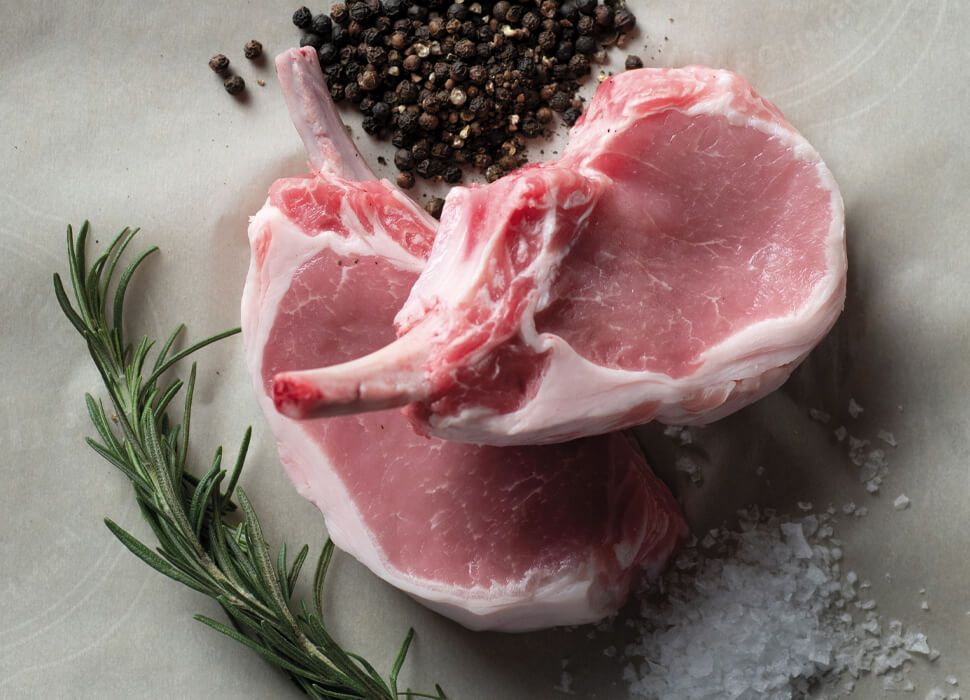We’re firing up the grill and sharing some tips for grilling pork to perfection.
Pork is a prime candidate for grilling. It cooks through quickly and takes on plenty of smoky flavor. And with a fresh salsa or a light herb sauce, it’s the perfect protein for warm summer evenings; add some roasted squash to your pork and you’ve got a delicious option for the Fall months as well.
Follow these steps for great grilling results!
Pick the Right Cut of Pork
Grillers have plenty of options to choose from when picking their proteins. Pork chops are delicious on the grill, and they cook quickly. Look for chops cut at least 1” thick, so they don’t cook too quickly and dry out. Bone-in or boneless pork chops are both great for grilling.
Pork tenderloin is another cut that’s ideal on the grill. Tenderloins are thicker in the middle, which helps them to stay nice and juicy while achieving a crisp crust.
For a real showstopper, try grilling pork shoulder or pork butt. These big cuts have to be cooked slowly over low, indirect heat. It could take up to 6 hours, but the result is ultra-tender pork that makes a wonderful weekend meal.
Pork sausages and hot dogs from Coleman Natural are also delicious on the grill, as long as you grill them right! Serve them in a bun, use them in Kielbasa and Veggie Kabobs, or slice them up and mix them with veggies in this Personal Foil Packet Dinner.

How to Prepare Your Pork Before Grilling
1. Season Your Meat
While you can choose any herbs and spices you like, don’t skimp on the salt! Pre-salting your pork will draw internal water to the surface. The liquid will then dissolve the salt and reabsorb back into the pork, allowing the salt to evenly distribute throughout the cut.
One thing to keep in mind when seasoning is your timing: the larger the piece of meat, the earlier you should salt it. For small pork chops, salting 30 minutes to two hours before cooking will be enough. For a big pork shoulder, salt well and let it rest overnight on a wire rack in the refrigerator.
2. Or Utilize a Brine
Another option is to brine your pork. A brine is a salty liquid that helps introduce moisture and salt into the meat. The amount of finished brine to make will vary depending on the size of your cut, as you just need enough to cover the meat completely.
To make a brine, heat the water over medium heat, and add salt when it reaches a simmer. Three cups of water with ¼ cup of salt is a good water-to-salt ratio. Next, you can add optional aromatics like citrus, bay leaves, peppercorns, or rosemary. Once the salt has dissolved and the flavors have melded together, chill the brine in the refrigerator then add the pork.
Pork chops only need about 30 minutes to brine—about as long as it takes to heat the grill. Don’t brine chops for more than four hours, or they can get too salty or the meat can become mushy. A pork tenderloin will need more time, so aim for two to four hours of brine time. And a large pork shoulder can brine overnight.
3. Add Flavor with Marinades, Rubs, and Sauces
One way to add extra flavor to your pork is via a marinade. Low salt marinades—like the marinade in these delicious Balsamic and Rosemary Grilled Pork Chops—can stay on your pork for much longer than a brine. And since a brine’s purpose is to add moisture and a marinade’s purpose is to bring more flavor, you can utilize both a brine and a marinade.. Marinades often include an acid, like vinegar or citrus, to help bring brightness to the dish.

Another way to add flavor after brining or salting is via a dry rub. First, pat your meat dry and then add additional spices and flavorings like garlic, onion, BBQ seasoning, fresh herbs…there’s no limit! Just don’t add more salt.
If you plan to brush your pork with a high-sugar sauce, wait to apply until the last few minutes of grilling to avoid burning.
How to Grill Pork Chops
Once your pork chops are properly seasoned, it’s time to get your grill ready. Before you start your coals, brush your grill grate clean and apply a light coating of cooking oil to prevent sticking.To obtain a beautiful sear and evenly-cooked interior, you’ll want to preheat one section of your grill to high heat and the other to medium heat. If you’re working with charcoal rather than a gas grill, wait until the grill forms high heat.
Place your chops on the hottest section of the grill for about two to three minutes per side. This will give the chops beautiful grill marks. After you’ve seared both sides, move the chops over to medium heat and cook for three to seven minutes per side.
If you’re worried about whether or not your chops are done, you can check the internal temperature with a meat thermometer. Check for a temperature of at least 145°F and a maximum 160°F.
When your pork chops have reached the appropriate temperature, remove them from the heat and let them rest on a plate, uncut, for at least three minutes. This preserves juices and ensures optimum flavor!
How to Grill Pork Tenderloin
While pork tenderloin takes a bit longer on the grill than pork chops, it can still make a quick weeknight meal. If your seasoned tenderloin is resting in the refrigerator, remove it and allow it to sit at room temperature for 30 minutes. In the meantime, bring one section of your grill to high heat.
Place your tenderloin over high heat and close the lid of the grill. After about three to five minutes, lift the lid, flip the tenderloin, and re-cover by closing the lid again. After the second side has cooked for another three to five minutes, move the meat over to an area of the grill that has low, indirect heat. After three to four minutes, flip once more.

At this point, you can check the internal temperature. Make sure to stick the thermometer into the thickest part of the tenderloin. Once it reaches 145°F to 160°F, it’s done.
Once you remove your tenderloin from the grill, let it rest for ten minutes. You can tent aluminum foil over the plate to help retain heat.
How to Grill Pork Butt
While pork butts are ideal on the grill, they require a different approach than smaller cuts of meat. Rather than relying on the grill’s high heat, you’ll be utilizing indirect heat for a low and slow approach.
When it’s time to prepare your grill, you want to aim for a temperature between 200 and 250°F. On a gas grill, you’ll want to place your pork away from the burner. On a charcoal grill, you can stack your white-hot briquettes on one side, and position the pork on the other side of the grill.
For an added smoky flavor, you can place wood chips near the heat source. Apple and hickory chips work well, as long as they’ve been soaked in water for a few hours.
Once the pork butt is on the grill, it’s time to practice patience. Cover the grill and step away, only lifting the lid to check on the heat and adjust if necessary. While pork butt is technically safe to eat once it reaches 160°F, it will need to reach 190°F to be tender enough to pull apart. The size of the butt impacts total cook time, but you can expect the process to take anywhere from four to six hours.
Once the pork butt has reached the optimum temperature, remove it from the heat, wrap it in aluminum foil, and allow it to rest for at least 30 minutes. After it has rested, you can shred it with a fork and add your favorite sauce.
Start with High-Quality Pork for the Best Results
Now that you know how to grill pork, the hardest part will be deciding which pork cut you want to enjoy first! No matter if you’re grilling up a pork shoulder or plate of pork chops, Coleman Natural can provide you with the high-quality pork you’re looking for. All of our animals are raised crate free on American family farms, with no added hormones or antibiotics and are 100% American Humane Certified.
So fire up the grill, pick up some of your favorite pork, and get ready to cook up a meal the whole family can enjoy.
Ready to learn more about cooking pork? Read these next:


